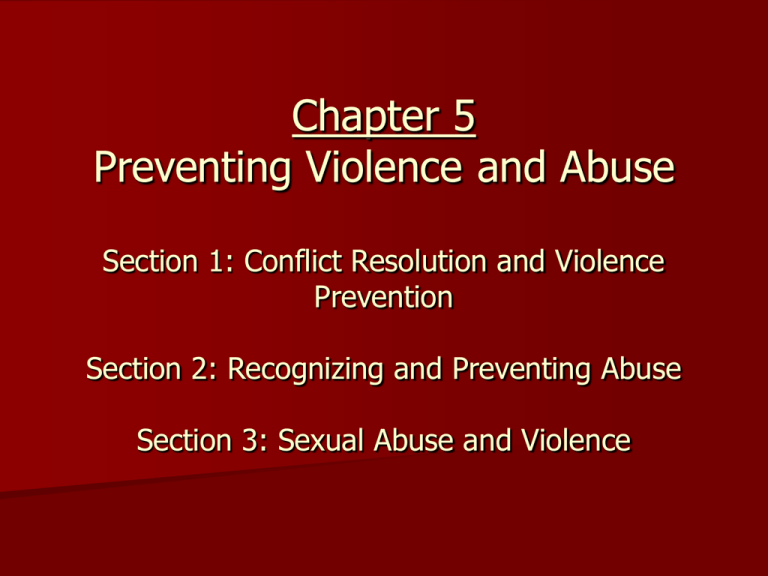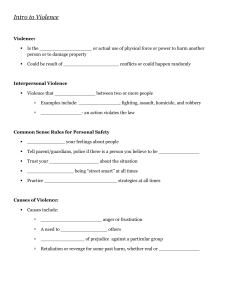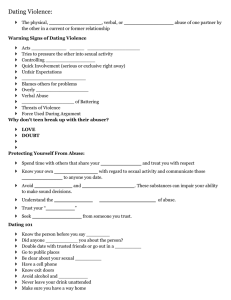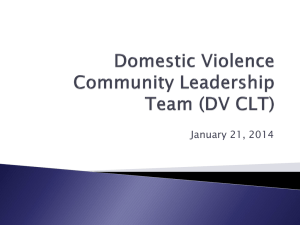
Chapter 5
Preventing Violence and Abuse
Section 1: Conflict Resolution and Violence
Prevention
Section 2: Recognizing and Preventing Abuse
Section 3: Sexual Abuse and Violence
Violence Around Us
Violence is any physical force that is used
to harm people or damage property
Violence has started to become a way of
life in our community
Observing and experiencing violence can
also make a person more violent towards
others
A conflict is another name for a fight or a
disagreement
Factors that Lead to Conflicts Between
Teens
Feeling threatened
Unmanaged anger
Lack of respect
Bullying
Gangs
Avoiding Dangerous Situations
Recognize the signs
Calm things down
Leave the situation
Firmly say you will not fight
Resolving Conflict Without Violence
Conflict resolution is a nonviolent way to
deal with arguments
Negotiate- bargain or compromise for a
peaceful solution to the problem
Peer mediation
Be assertive, use “I” messages, don’t
make assumptions, don’t raise your voice
Making GREAT Decisions
Give thought to the problem
Review your choices
Evaluate the consequences of each choice
Assess and choose the best choice
Think it over afterward
What is Abuse?
Abuse is physical or emotional harm to
someone
Unfortunately, the most common forms of
abuse come from people one should be
able to trust
Look for these characteristics in people:
controlling, obsessive, manipulative,
selfish, aggressive, needy, jealous, scary
temper, mean
Types of Abuse
Child abuse- physical abuse, emotional abuse,
sexual abuse, and neglect
Domestic abuse
Elder abuse
Hazing
Violence in domestic relationships often cycles
through three stages
Effects of Abuse
Depression
Low self-esteem
Poor appetite or overeating
Low energy or fatigue
Poor concentration and difficulty making
decisions
Difficulty sleeping
Feelings of worthlessness
Feelings of guilt, shame, and anxiety
Protecting Yourself From Abuse
Create a supportive network of friends and
family
Avoid disrespectful people
Be assertive
Show disapproval
Help for The Abused
Tell someone
Go somewhere safe
Consider counseling
Facts
30% of students are bullied or bully others
1 in 3 teens do not feel safe at school
As many as 3 million cases of child abuse
are reported every year in the U.S.
It is estimated that an act of domestic
abuse happens every 15 seconds in the
U.S.
Sexual Abuse
Any sexual act without consent
Incest- sexual activity between family
members who are not husband and wife
Child abuse is common and children feel
ashamed and are less likely to tell anyone
what is happening
Sexual Harassment
Any unwanted remark, behavior, or touch
that has sexual content
Examples: telling unwanted jokes, making
sexual remarks about a person’s clothing,
touching a person inappropriately, staring
at a person’s body parts, making sexual
gestures, continuously asking a person out
Responding to Sexual Harassment
There are two things you can do to stop
the harassment:
1. Tell the harasser to stop
2. Report the harassment
*Sexual harassment is illegal
Sexual Assault and Rape
Sexual assault is any sexual activity in
which force or the threat of force is used
Date rape is sexual intercourse that is
forced on a victim by someone the victim
knows
80% of victims of sexual assault and rape
know their attackers
Victims of sexual assault and rape suffer
both physical and emotional trauma
Protecting yourself from sexual
abuse and violence
Keep your doors and windows locked at
home, do not answer the door for
strangers
Do not walk alone at night
Keep your phone handy
If you are being attacked, call out for
help!
Help after a sexual assault
Make sure you are away from further
harm
Call for help
Don’t change anything about your body or
your environment
Ask someone to take you to the hospital
Seek therapy or counseling





